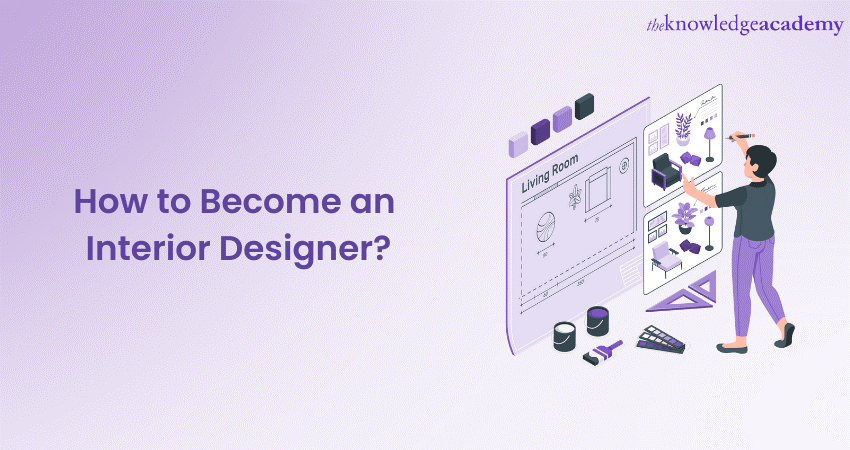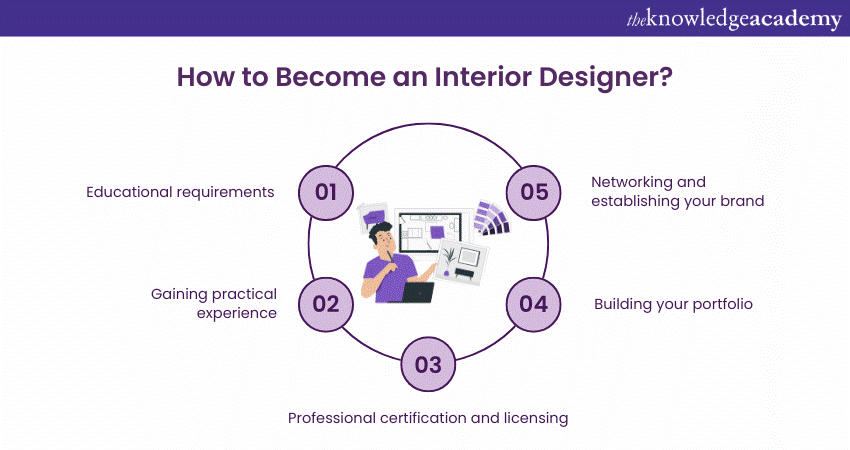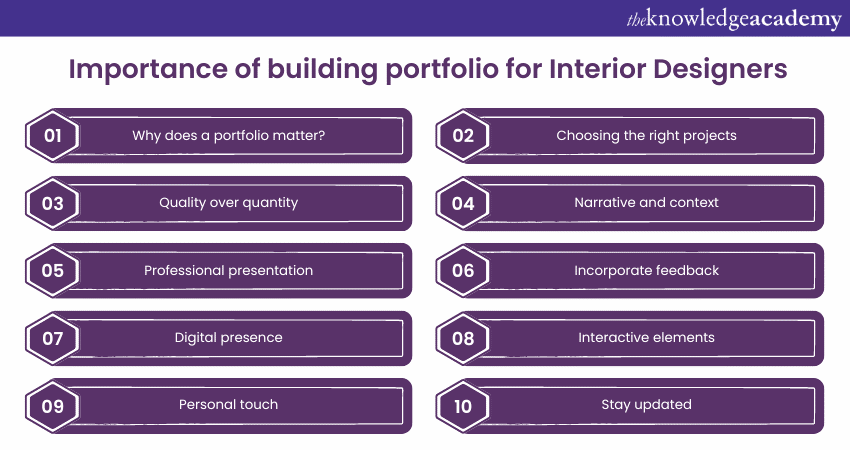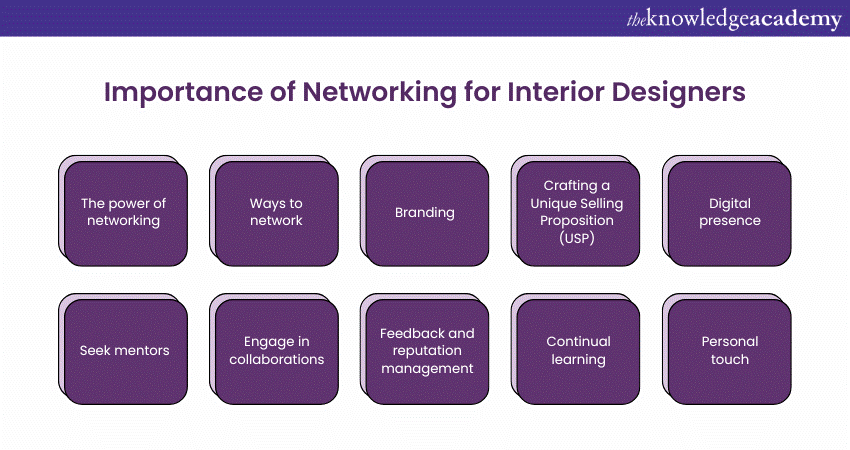We may not have the course you’re looking for. If you enquire or give us a call on 01344203999 and speak to our training experts, we may still be able to help with your training requirements.
Training Outcomes Within Your Budget!
We ensure quality, budget-alignment, and timely delivery by our expert instructors.

Ideation is the birth of creation. Decoration, space aesthetics and creativity can create a flair and sense of artistry. If decorating and creating is what you love, then a career in Interior Design can just be for you. ”How to become an Interior Designer?" is not a tricky question anymore. You get to create and bring your own style into spaces where people reside every day. Interior Designers are creative geniuses who make your home or office spaces come alive. They utilise every inch of your space to create betterment. If the question - How to Become an Interior Designer comes to your mind, then you are in the right place. If you are just starting out in Interior Design, then you must know all the basics to get started with precision. In this blog, you are going to learn step-by-step methods to help you start your journey in Interior Design. Read through to learn more!
Table of Contents
1) Who is an Interior Designer?
2) How to Become an Interior Designer?
a) Educational requirements
b) Gaining practical experience
c) Professional certification and licensing
d) Building your portfolio
e) Networking and establishing your brand
3) Conclusion
Who is an Interior Designer?
Interior Designer is responsible for planning and curating the aesthetic and functional aspects of any interior spaces. They play with light, structural integrity, human traffic flow, and furniture placement to enhance the livability. They are solely responsible for all the appeal of indoor environments.
Using a blend of art and science, they factor in elements like colour palettes, fabrics, furnishings, and architectural features to craft spaces that resonate with the inhabitants' lifestyles and preferences. Beyond mere aesthetics, Interior Designers possess a deep understanding of building codes, safety standards, and sustainability practices. Collaborating with architects, contractors, and clients, they transform visions into tangible realities, ensuring that spaces are not just beautiful but also practical and safe.

How to Become an Interior Designer?
Having an artistic side is indeed a boon. However, in order to hone your expertise, you need to follow a structured flow. In this section, you are going to learn the step-by-step processes of How to Become an Interior Designer.

Educational requirements
Interior Designing cannot fully depend on talent or mere education; it demands a combination of both talent and formal education. There are specific educational standards that are typically required. This helps in setting designers up for success. Listed below are some of the points that you need to remember:
1) Foundation courses: The basics of design introduce all basic principles of design. This includes elements like balance, harmony, contrast, and rhythm. Ater that comes the colour thoery, which explores the psychology, symbolism and application of colours in closed spaces.
2) Bachelor's degree: Most professionals begin their journey with a bachelor's degree in Interior Design or Interior Architecture. This works as the foundation of the profession. The degree typically spans for four years. The curriculum covers subjects ranging from spatial design, Computer-Aided Design (CAD), to the history of architecture and design.
3) Technical skills: The degree helps in acquiring technical skills such as – drawing techniques, computer visualisations, model making, concept development, etc.Computer-Aided Design (CAD) is essential for drafting and creating digital blueprints and models. Software like SketchUp or Revit allows designers to create 3D visualisations. Additionally of Adobe Creative Suite, especially Photoshop and Illustrator, is beneficial for rendering and presentation.
4) Specialised courses: Courses like lighting design, sustainable design and ergonomics enhances different skills. It includes aesthetic and effective usage of lights, eco-friendly and sustainable design practices. It also tries to keep in mind whether the designs cater to human comfort.
5) Advanced degrees: A master's program or a Ph. D. offers specialised knowledge. It also allows students to choose and focus on a particular design niche. This helps in creating in their own signature style later on in their career. Additionally, a Ph. D. certification helps individuals looking to contribute to academic research or teach at the university level.
6) Online courses: With the rise of digital platforms, many reputable institutions offer online Interior Design courses. This helps many students to learn at their own pace. Courses might range from fundamental concepts to specialised areas like 'biophilic design' or 'minimalist interiors'.
7) Diverse learning: A sound understanding of architectural evolution can offer valuable context. As many designers eventually venture into freelance work or establish their firms, a grasp of business basics becomes crucial.
Enhance your drafting expertise – Register now for our AutoCAD LT Training - register now!
Gaining practical experience
The hands-on exposure as an Interior Designer helps you bridge the gap between classroom knowledge and real-world application. Here are some points to help you get a better understanding:
Practical experience allows you to apply their all the learned theories and to see how they come to life in projects. Real-world challenges and on-field challenges differ are a little different from classroom assignments. Addressing actual client concerns, budget constraints, and unexpected issues provides a holistic learning experience. It also helps in developing effective risk management skills. Every project undertaken is a potential portfolio piece, a testament to one’s skills, creativity, and problem-solving ability.
Interning with established designers or reputed firms offers invaluable insights. From client meetings to Project Execution, you can witness the end-to-end process. Working under seasoned professionals offers you the chance to receive guidance, feedback, and, occasionally, constructive criticism. Networking is another plus point. Internships can lead to industry connections, potential job offers, and even client referrals.
After graduation, you can begin as a junior designer in firm. This position often involves assisting senior designers, understanding client briefs, and handling specific project segments. Autonomy with supervision: Unlike internships, junior designers have more responsibilities, but the safety net of supervision ensures they can seek guidance when needed.
Freelancing allows emerging designers to build their brands. They directly interact with clients, manage projects, and have creative freedom. Freelancers often work on varied projects making a diverse portfolio. I ranges from residential makeovers to corporate redesigns, allowing for a rich and diverse portfolio. Juggling multiple roles, from client acquisition to budgeting, sharpens entrepreneurial skills.
Collaborating with peers on projects can be a learning experience. Different designers bring unique perspectives and solutions to the table. Interdisciplinary exposure: Collaborating with professionals from allied fields, like architects or landscape designers, offers a broader understanding of the design ecosystem.
Collaborating with peers on projects can be a learning experience. Different designers bring unique perspectives and solutions to the table. Collaborating with professionals from allied fields, like architects or landscape designers, offers a broader understanding of the design ecosystem.
Offering services for free, especially in the early stages, can be a platform to demonstrate skills, earn client testimonials, and make a positive impact. Engaging in community projects or nonprofit redesigns not only enhances the experience but also contributes to societal betterment.
Professional certification and licensing
For Interior Designers, further professional recognition in the form of certifications or licenses can prove invaluable. Not only does this showcase a designer's commitment to the industry, but it also lends credibility to their practice. Here are some points to help you get a better understanding:
1) Why do professional certification and licensing matter: Professional certification and licensing matter due to the following reasons. Such credentials confirm that a designer has met specific industry standards and possesses the necessary expertise. Clients often feel more confident hiring someone with recognised qualifications. In some regions or for certain projects, being licensed might be a legal necessity.
2) Types of certifications: In the U.S., the NCIDQ certification is a gold standard. It requires a combination of education and work experience, followed by a rigorous examination. This organisation in the UK provides a range of flexible, online Interior Design courses at all three levels – diploma, undergraduate and Masters. There are certifications for niche areas like green or sustainable design, lighting, or ergonomics.
3) Process of getting certified: Most certifications require a combination of formal education and work experience. For example, the NCIDQ requires at least a bachelor’s degree and two years of full-time work experience. After meeting the eligibility criteria, candidates must pass an exam that tests both theoretical knowledge and practical skills. When you become a working professional, you might need to renew the certifications periodically. This helps in ensuring that they remain updated with industry standards.
4) Licensing: The process and requirements for obtaining a license vary based on the state or region. Some areas might mandate designers to be licensed before practising, especially for specific project types. Much like certification, obtaining a license generally requires passing a standardised exam.
5) Benefits of certification and licensing: Certified or licensed designers often command higher fees due to their validated expertise. Certain clientele, especially corporate or government clients, might exclusively opt for certified professionals. With credentials, designers might find doors open for senior roles or specialised projects.
6) Continued education: Certification bodies often necessitate members to undergo periodic continued education. These can be platforms for designers to refresh their skills, learn about emerging trends, and fulfil any continued education requirements.
7) Professional associations: Many professional design associations offer certification programs, provide resources for continued learning, and offer platforms for networking. Being part of professional bodies can also mean being part of a larger voice. It advocates for the rights, recognition, and advancement of Interior Designers.
8) Ethical considerations: Licensed and certified professionals often have to adhere to a code of ethics. This helps in ensuring that they maintain the highest standards of practice. With a license or certification comes increased responsibility. Clients and employers have a clear benchmark to hold designers accountable to.
9) Global recognitions: If you are looking to work across borders as Interior Designers, international certifications or recognitions can be beneficial. Some credentials are recognised globally, or there might be pathways to convert one's certification to match international standards.
10) Financial implications: While there is an investment involved in obtaining and maintaining certifications or licenses, the potential Return on Investment (ROI) in career advancement and increased earnings can make it worthwhile.
Building your portfolio
In a visually driven industry, the portfolio acts as a resume. This portfolio highlights your capabilities and vision as an Interior Designer. Whether you're just starting out or revisiting your professional journey, here's a comprehensive look at building a compelling portfolio. Here's why building a portfolio is crucial for Interior Designers:

1) Why does a portfolio matter:
Before even meeting you, clients or employers will judge your proficiency based on your portfolio. It offers a visual narrative of your skills. A well-maintained portfolio chronicles your evolution as a designer, showcasing the breadth and depth of your experience
2) Choosing the right projects
Incorporate projects that showcase a variety of styles, spaces, and challenges. From residential to commercial spaces or contemporary to vintage styles, demonstrate versatility. If you've undertaken projects that required unique solutions or highlighted niche skills, ensure they are featured.
3) Quality over quantity:
Instead of overloading your portfolio with numerous projects, select those that best represent your skills, creativity, and problem-solving ability. Ensure all images are of high quality, clear, and well-lit. Blurry or low-quality photos can detract from even the most impressive designs.
4) Narrative and context:
If possible, include 'before' shots alongside the 'after'. This difference underscores the transformation and the challenges overcome. Accompany visuals with brief descriptions. Outline client briefs, design objectives, challenges faced, and solutions adopted. This adds depth and context to each project.
5) Professional presentation:
The layout of your portfolio should be clean. A well-structured portfolio allows your work to shine. Avoid overly decorative or distracting elements, it at times, takes away the sophistication from the design. Maintain a consistent theme throughout, be it in the choice of fonts, colours, or presentation style.
6) Incorporate feedback:
Include positive feedback or testimonials from clients, adding a layer of trust and validation to your work. Periodically revisit and critically evaluate your portfolio, making room for improvement or updating it with new projects.
7) Digital presence:
Having an online portfolio is crucial. Platforms like Behance, or personal websites, offer global exposure. Platforms like Instagram or Pinterest can be powerful tools for designers. They act as an extension of your portfolio, reaching a broader audience and showcasing your ongoing work.
8) Interactive elements:
Incorporate walkthrough videos or 3D visualisations if available. They offer a more immersive experience of the space. Showcasing sketches, mood boards, or conceptual models can give viewers insights into your creative process.
9) Personal touch:
A brief professional biography helps potential clients or employers understand your journey, inspirations, and design philosophy. If you've undertaken personal projects or pro bono work, include them. They often highlight passion and self-initiative.
10) Stay updated:
Design trends, styles, and technologies evolve. Regularly update your portfolio to include recent projects and ensure it remains relevant. Apart from projects, mention any advanced training, workshops, or certifications you've acquired.
Dive deep into CAD proficiency with our BricsCAD Masterclass - join today!
Networking and establishing your brand
The importance of relationships and brand identity in this industry cannot be overstated. Here's an in-depth exploration of networking and brand establishment for budding Interior Designers like you:

1) The power of networking:
Networking isn't just about collecting contacts. It's about building genuine, mutually beneficial relationships. Such associations can lead to collaborations, referrals, and new opportunities. Interacting with fellow designers can provide insights into new trends, business practices, and industry challenges.
2) Ways to network:
Attend design exhibitions, conferences, and workshops. These events give you opportunities to meet industry leaders, potential clients, and fellow designers. Joining associations like the American Society of Interior Designer (ASID) can offer networking platforms and increase your industry visibility. Websites like LinkedIn or design-focused platforms like Behance can help connect with professionals from around the world. Engage in local community events or workshops. These can be platforms to meet potential clients or collaborators.
3) Branding:
Your brand is a representation of your design philosophy, work ethic, and values. It's a combination of visual elements, like logos and colour palettes, and intangibles, like reputation and service quality. Whether it's your business card, website, or social media, ensure consistency in design and messaging. This strengthens brand recall.
4) Crafting a Unique Selling Proposition (USP):
With numerous talented designers in the industry, your USP could be your design style, sustainable practices, or innovative solutions. Ensure that potential clients and collaborators are aware of what sets you apart. Highlight this in your marketing materials and conversations.
5) Digital presence:
A professional website acts as a digital portfolio and a representation of your brand. It should reflect your style and showcase your best work. Platforms like Instagram, Pinterest, and Twitter can be used to share your projects, industry insights, and interact with a wider audience. Consistent posting and engagement can enhance brand visibility.
6) Seek mentors:
Seasoned designers or industry leaders can offer invaluable advice on navigating the industry, avoiding pitfalls, and building your brand. A mentor can introduce you to their network, vouch for your skills, and even recommend you for projects.
7) Engage in collaborations:
Collaborate with fellow designers, architects, or artists on projects. Such partnerships can expand your network and introduce you to their client base. Showcase these collaborations prominently in your portfolio and on social media to highlight teamwork and versatility.
8) Feedback and reputation management:
Encourage satisfied clients to leave positive reviews or testimonials. Word of mouth remains a potent tool in the design world. Constructively address any negative feedback and strive to improve. This demonstrates professionalism and commitment to excellence.
9) Continual learning:
The design world is dynamic. Regularly update yourself on trends and technologies, enhancing your brand's reputation as innovative and current. Conduct workshops, webinars, or write articles. Sharing knowledge can position you as an industry expert and strengthen your brand.
10) Personal touch:
In all your networking and branding endeavors, remain genuine. Authenticity resonates and helps in building lasting relationships and a trustworthy brand.
Conclusion
In this blog on How to Become an Interior Designer, you got to know the importance of merging talent with strategic networking and a distinct brand identity. While your designs captivate, it's the relationships you nurture and the consistent brand image you project that solidify your foothold in the industry.
Master architectural modeling with our Revit Architecture Masterclass.
Frequently Asked Questions

Interior Designers make indoor arears functional and safe. A major element of this is beautification. By determining space requirements, selecting essential and decorative items, such as colours, lighting, and materials, brings out life in the interiors.

According to Glassdoor, the average salary for a Interior Designer is £38979 per year in United Kingdom.

The Knowledge Academy takes global learning to new heights, offering over 30,000 online courses across 490+ locations in 220 countries. This expansive reach ensures accessibility and convenience for learners worldwide.
Alongside our diverse Online Course Catalogue, encompassing 17 major categories, we go the extra mile by providing a plethora of free educational Online Resources like News updates, blogs, videos, webinars, and interview questions. Tailoring learning experiences further, professionals can maximise value with customisable Course Bundles of TKA.

The Knowledge Academy’s Knowledge Pass, a prepaid voucher, adds another layer of flexibility, allowing course bookings over a 12-month period. Join us on a journey where education knows no bounds.

The Knowledge Academy offers various AutoCAD Courses including Civil 3D Training, Revit Structure Course, and AutoDesk Maya Training. These courses cater to different skill levels, providing comprehensive insights into 20 Amazing Drawing Styles You Should Try.
Our Office Applications Blogs cover a range of topics related to leadership approach, offering valuable resources, best practices, and industry insights. Whether you are a beginner or looking to advance your leadership skills, The Knowledge Academy's diverse courses and informative blogs have you covered.
Upcoming Business Skills Resources Batches & Dates
Date
 Interior Design Course
Interior Design Course
Thu 1st Aug 2024
Thu 28th Nov 2024







 Top Rated Course
Top Rated Course


 If you wish to make any changes to your course, please
If you wish to make any changes to your course, please


